Discovering Romania
It’s 4:15pm and the cow is staring at a pathetic bundle of wet nylon trudging through the mud. The bundle is me and this is the story of how I got there and why I struggle to appreciate this strange, backward, beautiful country

It’s 4:15pm and the cow is staring at a pathetic bundle of wet nylon trudging through the mud. The bundle is me and this is the story of how I got there and why I struggle to appreciate this strange, backward, beautiful country.
We’re in Romania, this cow and I, and its stare is familiar to me.
If you spend any amount of time in the Eastern European country of my birth, The Stare becomes an expected part of nearly every interaction, and not just with bovines. It’s a potent cocktail made up of equal parts skepticism, disdain, and condescension and your average Romanian executes it with Olympic skill.
It’s 2015 and I’m partway through a hike when a torrential downpour strands me alone in the middle of a remote, spectacular national park called Padiș. Like a true lost world, Padiș is nestled in the Apuseni mountains and is home to a panoply of rare plant and animal life. It’s taken me the better part of a day just to get here thanks to the worst road I have ever driven on.
Despite being covered in mud, soaked, and exhausted after hours of driving and hiking, I couldn’t be happier. This is one of the most pristine, peaceful wilderness areas I’ve ever seen.
 Panoramic shot of the Padiș plateau. iPhone 6 Plus: 1/2639 @ ƒ/2.2, ISO 32
Panoramic shot of the Padiș plateau. iPhone 6 Plus: 1/2639 @ ƒ/2.2, ISO 32
The cow was less impressed. She, and too many other Romanian citizens, take such wonders for granted.
Regional politics have left the park virtually inaccessible from one side, yet furnished with a world-class highway on the other. The two provinces it straddles couldn’t come together to provide a single road that traverses the area.
It’s a small but telling example of Romania’s deep-seated political and social problems.
 The sign hardly needs translating. Tragic irony crosses language barriers. Fujifilm X-Pro 2 + 23mm: 1/5000 @ ƒ/2.2, ISO 200
The sign hardly needs translating. Tragic irony crosses language barriers. Fujifilm X-Pro 2 + 23mm: 1/5000 @ ƒ/2.2, ISO 200
Years of illegal logging have devastated entire ecosystems in areas like the one my family cottage is in, and the new laws that are finally slowing the carnage leave locals with no livelihood.
 This used to be a dense forest. Fujifilm X-Pro 2 + XF 23mm: 1/600 @ ƒ/8, ISO 200
This used to be a dense forest. Fujifilm X-Pro 2 + XF 23mm: 1/600 @ ƒ/8, ISO 200
Their frustrations are taken out on the animals.
Towns are full of starving dogs, and I have watched—horrified—as farmers beat their cows until the pine branch breaks across the animal’s bloodied back. I was a child the first time I witnessed this kind of cruelty. I remember seeing my neighbour’s grandson swing cats around by their tails, like an awful lasso. It was a game to him, the animal merely a toy.
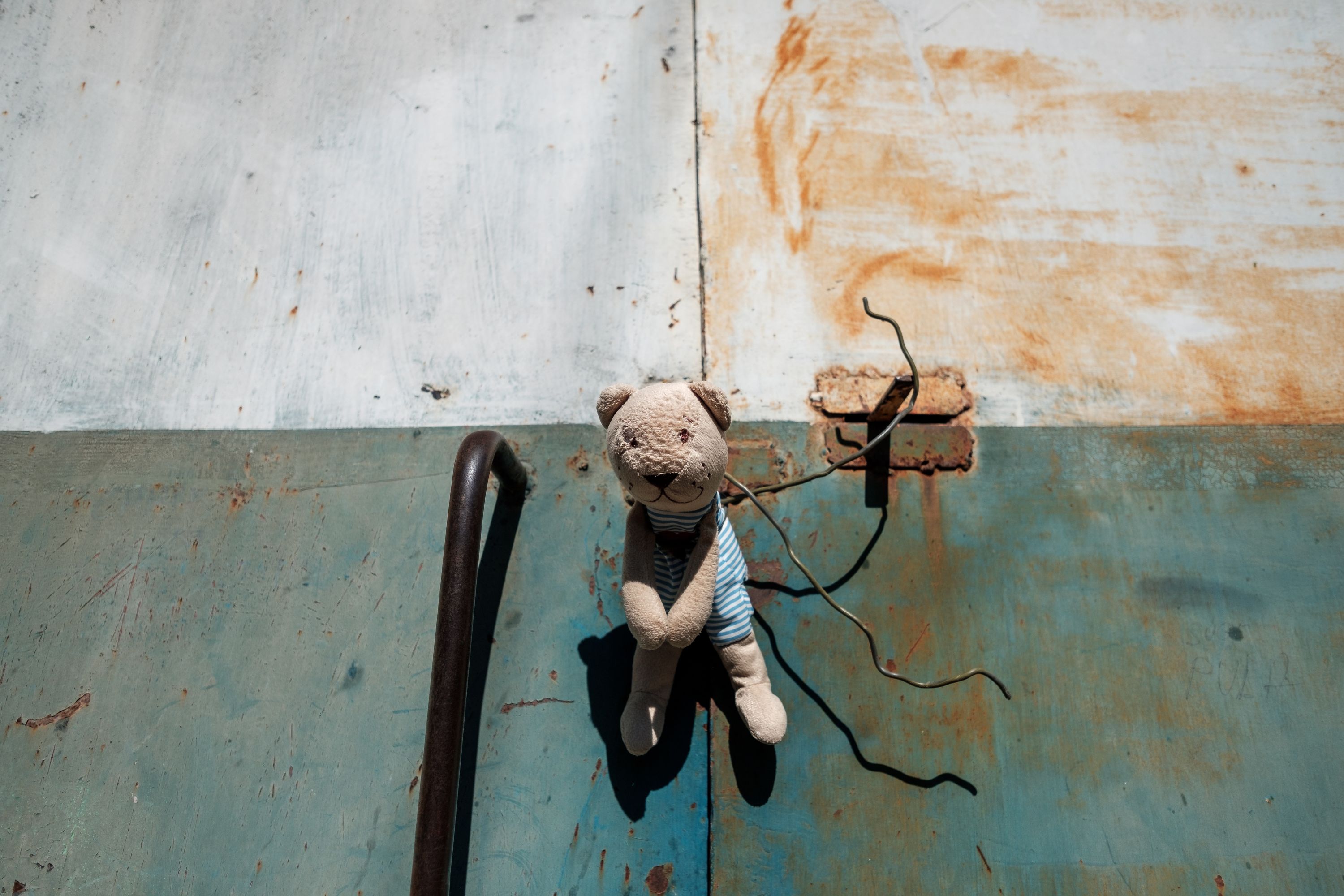 Fujifilm X-Pro 2 + XF 14mm: 1/2700 @ ƒ/2.8, ISO 200
Fujifilm X-Pro 2 + XF 14mm: 1/2700 @ ƒ/2.8, ISO 200
I stopped him, but what small respite I brought seems futile.
My heart breaks for every assault I’m not there to stop, every farm I’m not close enough to defend, every animal left to suffer at the hands of people who aren’t equipped to control their rage. Victims of circumstance are everywhere, and blame is difficult to assign.
If evil lurks in Romania, it comes in the form of desperate people, not vampires.
Yet for every region like this, there are others where animals are loved and cared for, where the people are kind, the environment is respected, and natural treasures are protected.
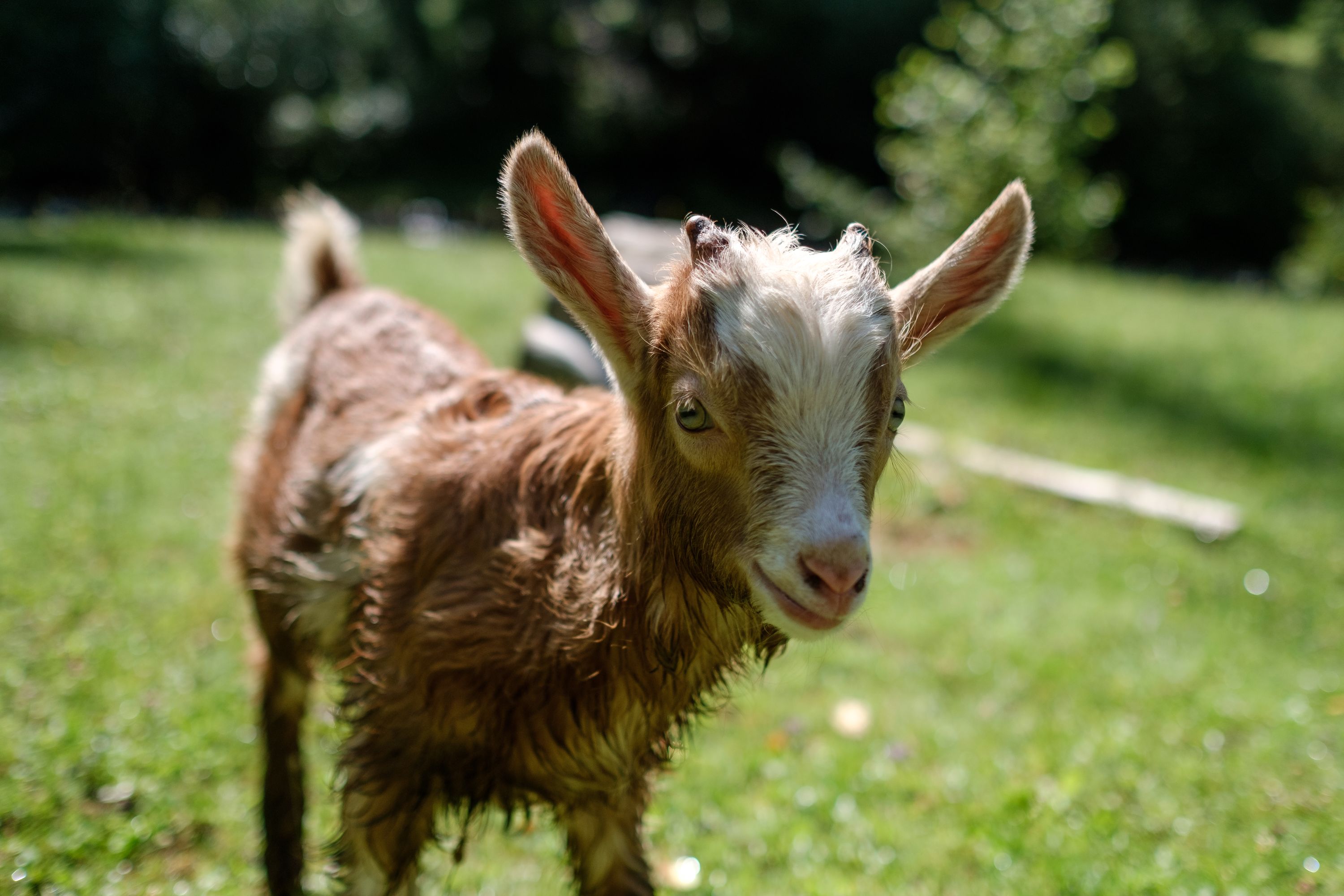 This young goat was excited to play after a refreshing dip in the local stream. Fujifilm X-Pro 2 + XF 23mm: 1/6400 @ ƒ/1.8, ISO 400
This young goat was excited to play after a refreshing dip in the local stream. Fujifilm X-Pro 2 + XF 23mm: 1/6400 @ ƒ/1.8, ISO 400
From this mire of contrasting experiences, I’m left struggling to love my country. I feel like an alien here, and the truth is that I’m more foreigner than local. I did not experience its troubled Communist period, I did not study its fascinating history, and I have not lived here for more than a month or two at a time.
I can’t judge Romania until I understand it, and I’m beginning to realize I can never truly understand it.
Nevertheless, I can recognize that today’s Romania—the one I’ve been visiting for twenty years—is a pale shadow of its true self. The tip of an iceberg, dirty and melting. Its true visage is hidden, and last year’s trek to Padiș was the beginning of an important lesson: the effort of discovery is worth it.
Romania hides a bounty of spectacular landscapes, amazing food, and noble history. It’s a country full of intelligent, thoughtful people whose reputation is tarnished by its more loud-mouthed, petty, and unpleasant citizens. Some day, perhaps the country will emerge from its post-Communist stupor and begin to properly appreciate and reveal its riches to the world, but until then I’m determined to dig, struggle, and persevere to find them on my own.
Which brings me to this year’s road trip.
From the tops of mountains to the depths of the caves beneath them, this summer was a valuable step forward in my quest to discover Romania.
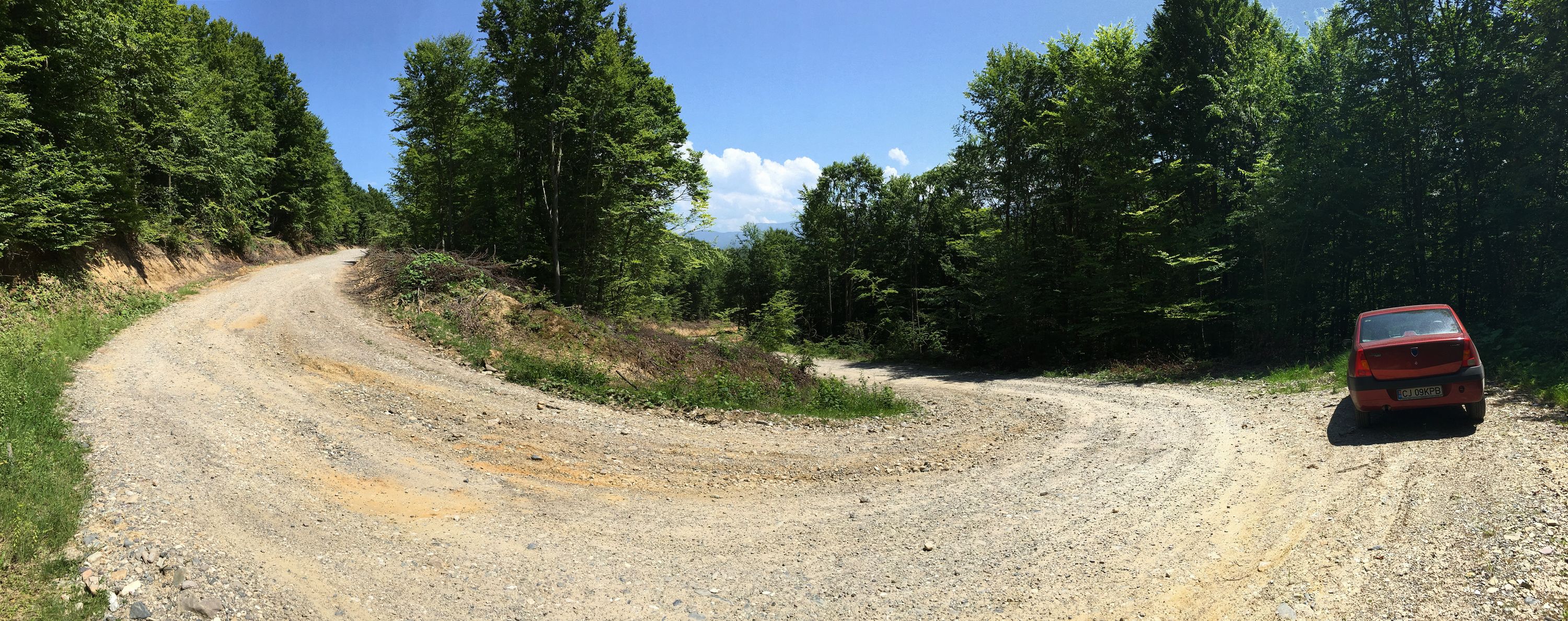 Tight turns and dirt roads are a common sight when navigating rural Romania. iPhone 6s Plus: 1/923 @ ƒ/2.2, ISO 25
Tight turns and dirt roads are a common sight when navigating rural Romania. iPhone 6s Plus: 1/923 @ ƒ/2.2, ISO 25
Transalpina
Officially, King Carol II opened Transalpina, a 140km-long road through the Parâng Mountains, in 1938. Locals still call it Drumul Regelui (“The King’s Road”).
However, the murky depths of history suggest the road was actually built centuries before by the Roman Empire as a means to reach their local stronghold at Sarmisegetuza.
 Fujifilm X-Pro 2 + 14mm: 1/850 @ ƒ/3.6, ISO 400
Fujifilm X-Pro 2 + 14mm: 1/850 @ ƒ/3.6, ISO 400
It remained a difficult passage until World War II when the Germans rebuilt it, and it wasn’t until 2012 that it opened to general traffic. Even now, properly paved and maintained, it remains open only during the summer months (when it isn’t buried in snow).
At its highest point, the road passes along the mountains’ crest, offering spectacular views of the landscape below.
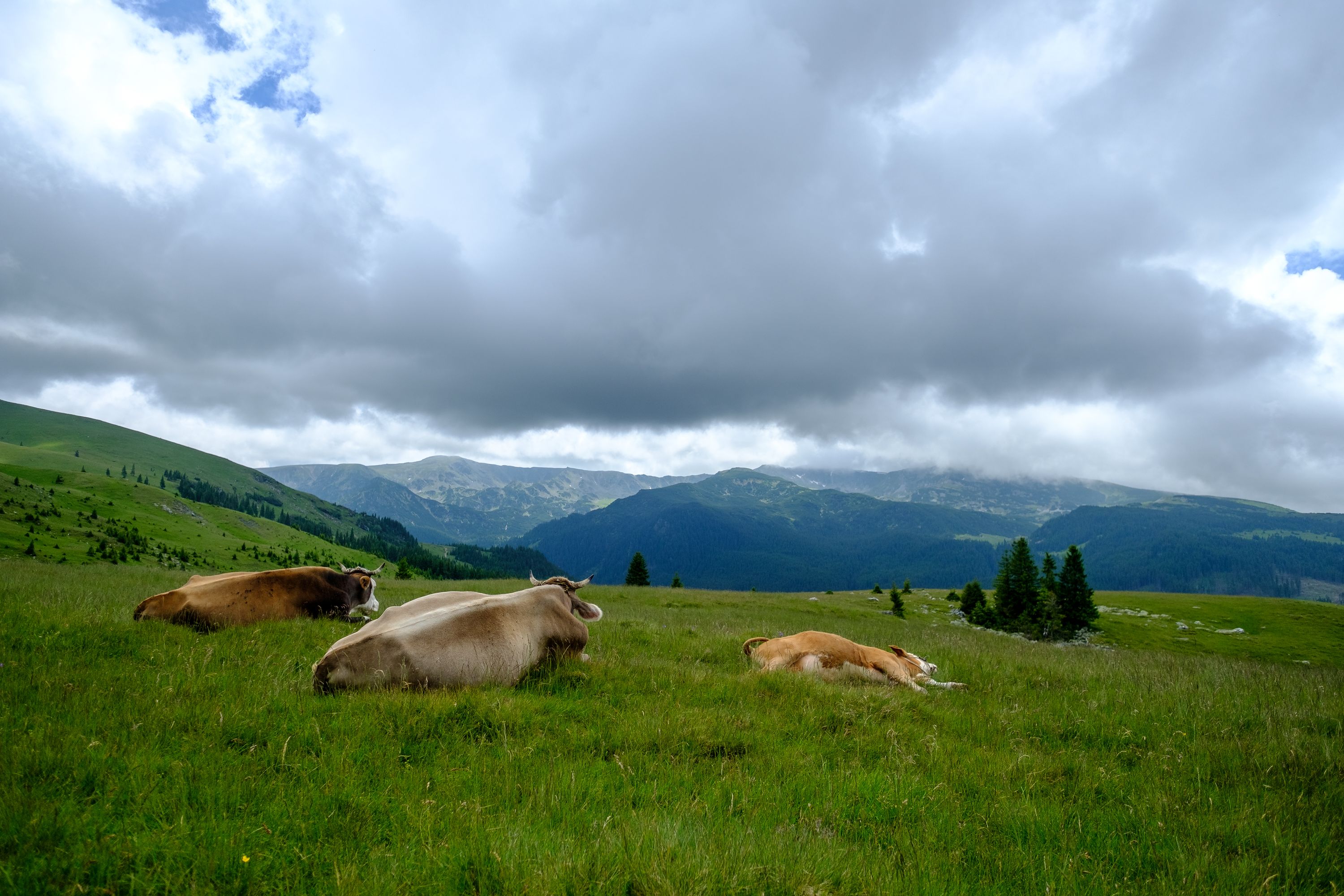 It’s not just people enjoying the view. Fujifilm X-Pro 2 + 14mm: 1/1250 @ ƒ/3.2, ISO 400
It’s not just people enjoying the view. Fujifilm X-Pro 2 + 14mm: 1/1250 @ ƒ/3.2, ISO 400
It’s here, more than 2km above sea level, that I encounter the world’s cutest puppy.
 Here he is making sure my mum is safe before retreating for another nap. iPhone 6s Plus: 1/610 @ ƒ/2.2, ISO 25
Here he is making sure my mum is safe before retreating for another nap. iPhone 6s Plus: 1/610 @ ƒ/2.2, ISO 25
Only a few weeks old, this Carpathian shepherd pup lives a simple life atop the mountain at a stână de oi (a sheepfold). When he grows up, he’ll help keep the herd safe as they graze on the mountain, and his cuteness will help bring visiting tourists to see the small room nearby where locals have created a small museum to the old ways of life. Blankets, traditional clothing, and painted pottery adorn a room frozen in time.
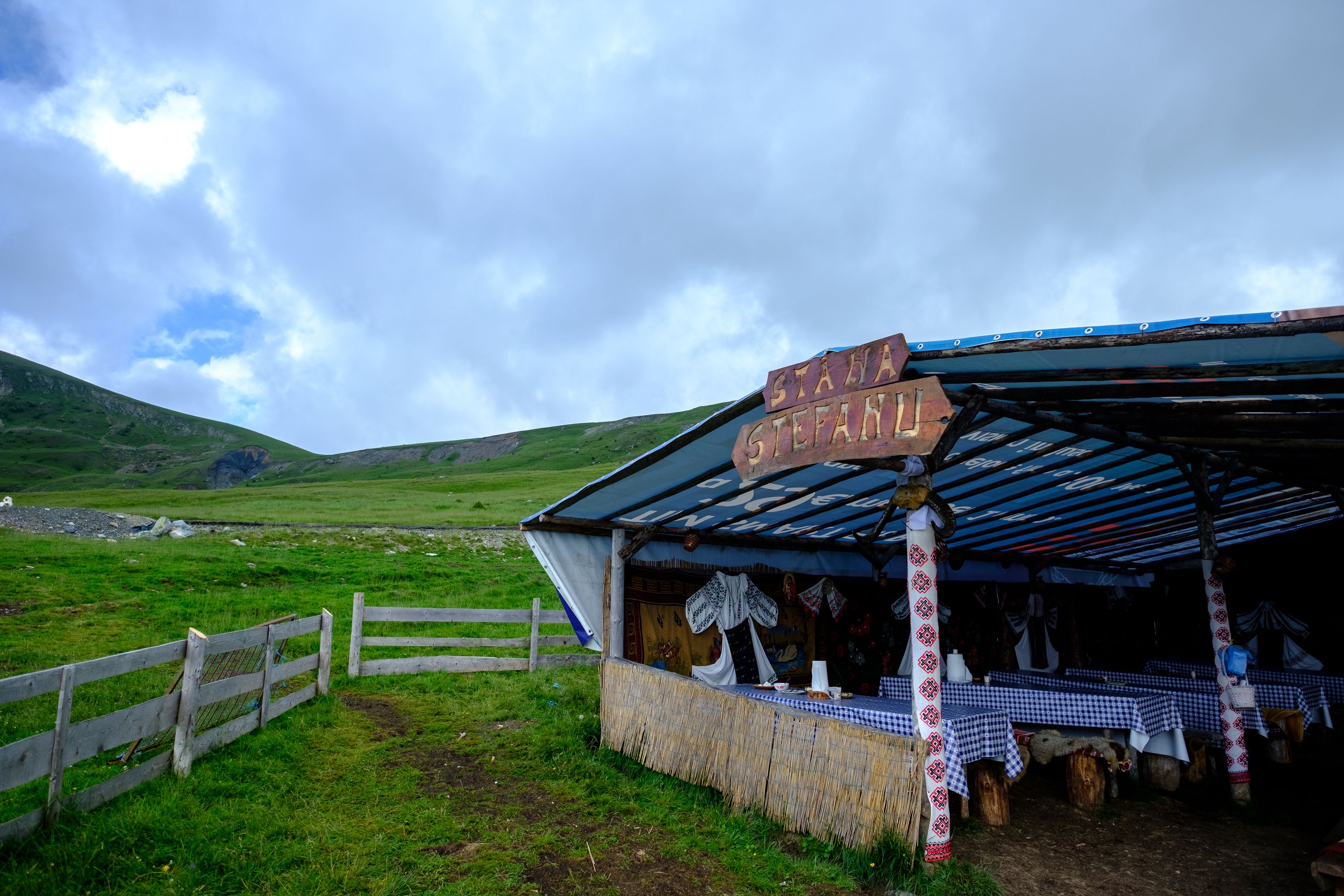 Fujifilm X-Pro 2 + 14mm: 1/320 @ ƒ/3.6, ISO 400
Fujifilm X-Pro 2 + 14mm: 1/320 @ ƒ/3.6, ISO 400
Two skinned sheep hang by a fire outside, a step too far toward authenticity for my Canadian sensibilities. Beside them, the owners are sitting on stools, smoking cigarettes and talking on their cellphones, wearing a parody of fashionable American clothing circa 1985. I decline to photograph the scene.
Passing the stână brings us to the peak, where a breathtaking vista awaits us.
 iPhone 6s Plus: 1/2404 @ ƒ/2.2, ISO 25
iPhone 6s Plus: 1/2404 @ ƒ/2.2, ISO 25
It’s June 29th as we traverse this road, and there is still snow hiding in the shadier nooks and crannies of the rock, despite the sweltering heat.
We’re lucky; it’s been raining for almost a month, but on the day we visit, Transalpina presents a photogenic face, with fast-moving clouds casting beautiful patterns across the landscape.
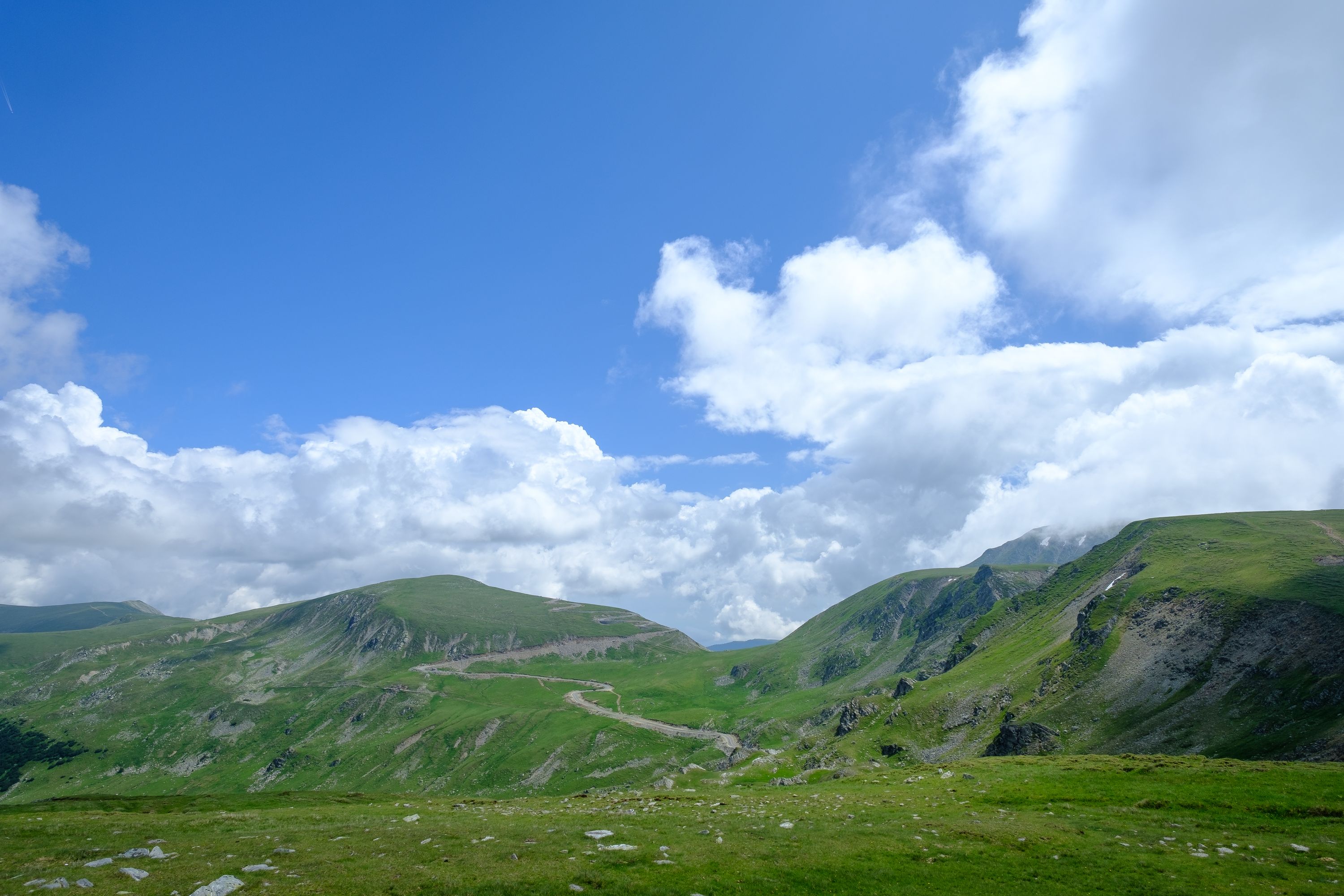 Besides the highway, farm roads also wind their way over the mountains. Fujifilm X-Pro 2 + 14mm: 1/1600 @ ƒ/4, ISO 400
Besides the highway, farm roads also wind their way over the mountains. Fujifilm X-Pro 2 + 14mm: 1/1600 @ ƒ/4, ISO 400
It’s too rocky for farmland, but the rains have made the grassy plains a perfect grazing spot for sheep and goats. And not just the domestic variety.
Climbing to the top of a rocky outcropping for a better view, I startle a Carpathian chamois, a type of mountain goat native to the area. It’s gone in the blink of an eye, long before I have time to swing my camera around for a shot. Later, I see one clambering up a sheer rock face far in the distance.
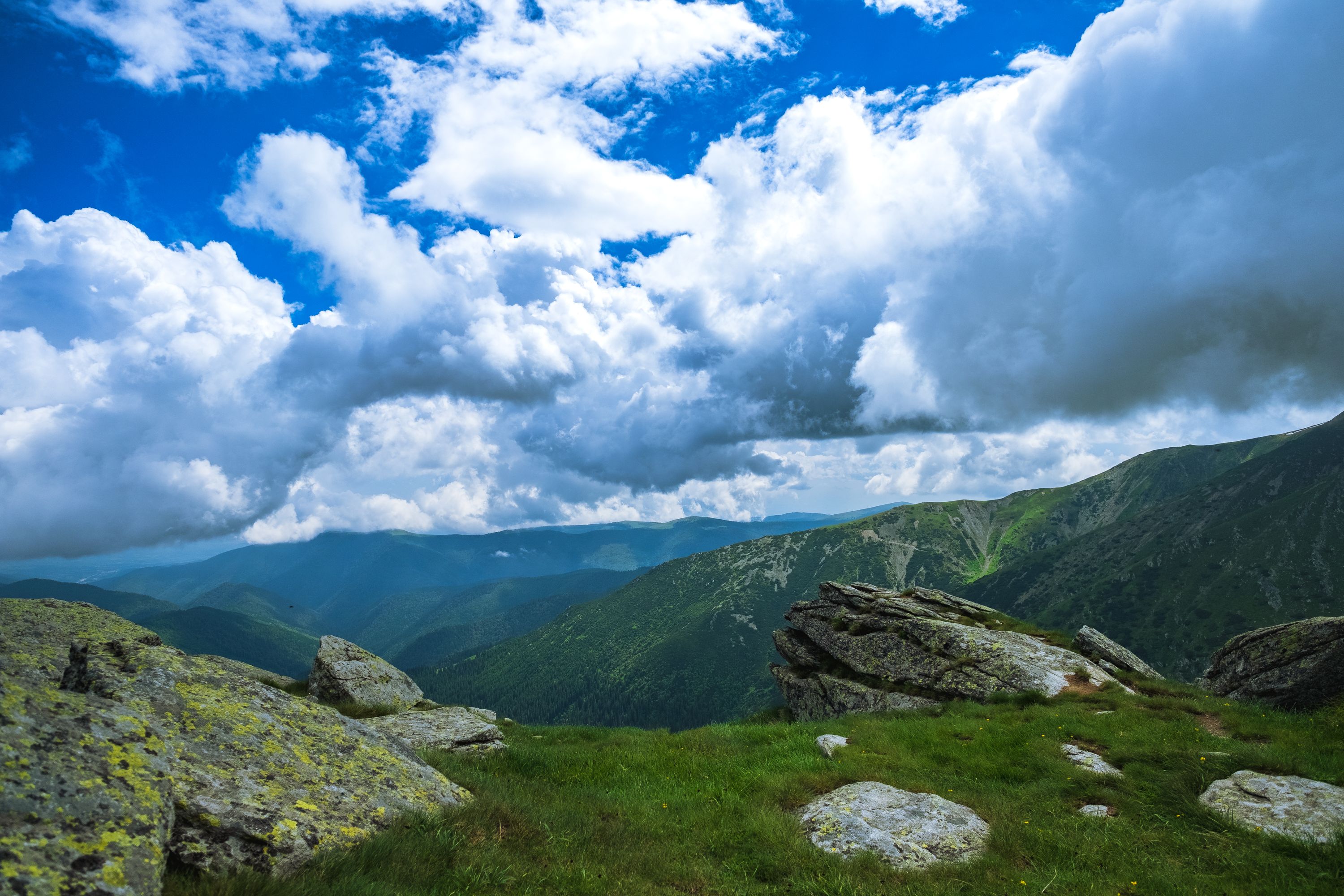 I wasn’t quick enough to snap a shot of the chamois, but the view was worth the hike. Fujifilm X-Pro 2 + 14mm: 1/1600 @ ƒ/4, ISO 400
I wasn’t quick enough to snap a shot of the chamois, but the view was worth the hike. Fujifilm X-Pro 2 + 14mm: 1/1600 @ ƒ/4, ISO 400
Surprisingly fluorescent green lichen clings to the stones jutting from the ground, and nestled amongst them is some truly unique plant life.
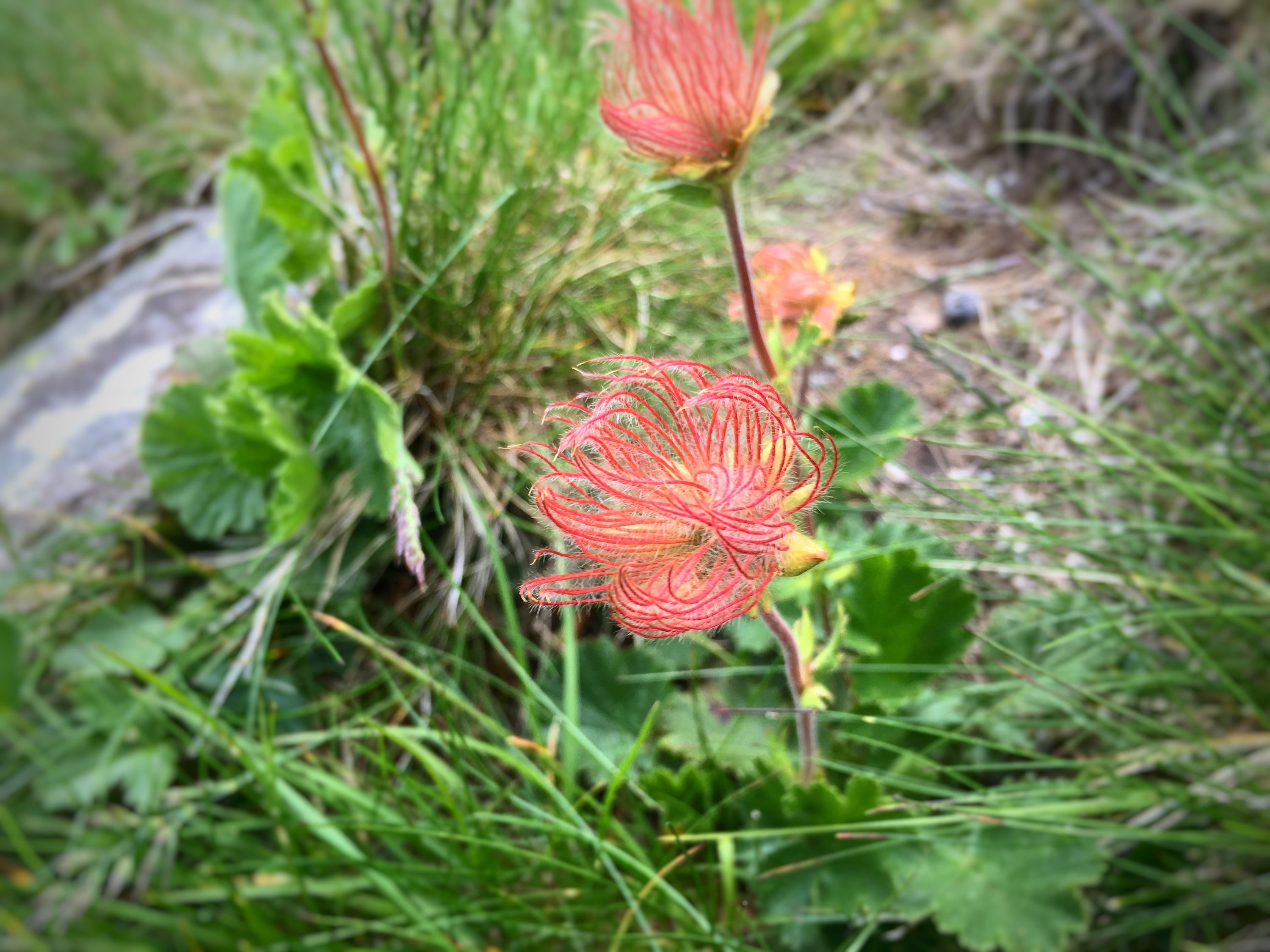 It looks like an alien flower, but it’s actually the seed head of an alpine avens (Geum montanum). iPhone 6s Plus: 1/216 @ ƒ/2.2, ISO 25
It looks like an alien flower, but it’s actually the seed head of an alpine avens (Geum montanum). iPhone 6s Plus: 1/216 @ ƒ/2.2, ISO 25
The drive took us the better part of a day, which included lots of time for photo breaks along the way. The asphalt is good enough and traffic light enough that it could be done quicker, but what’s the point?
Just as we cleared the peak, a cloud bank rolled in and kept us company along the descent.
A Subterranean Diversion
There are more than 12,000 caves in Romania.
Of those, comparatively few are open to the public, but it just so happens that several of the more famous ones were located close to our route.
Including Scărișoara.
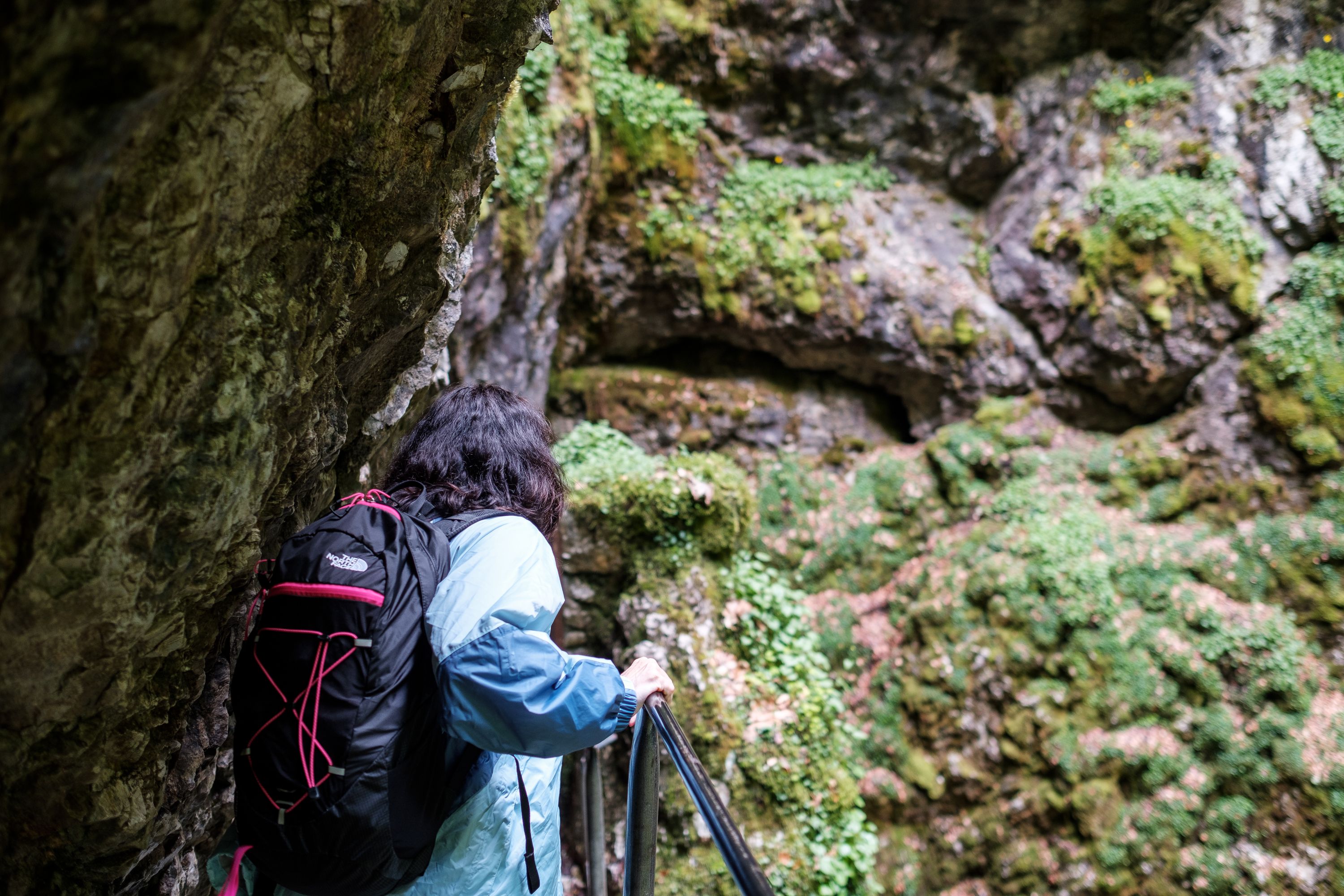 Navigating the metallic stairs descending into Scărișoara. Fujifilm X-Pro 2 + 23mm: 1/105 @ ƒ/2 ISO 400
Navigating the metallic stairs descending into Scărișoara. Fujifilm X-Pro 2 + 23mm: 1/105 @ ƒ/2 ISO 400
Discovered in the 1800s, the cave at Scărișoara formed more than 3,000 years ago when the entire mountain range was covered in ice. It’s still frozen today, and it’s notable for being one of the largest ice caves in Romania.
Even on a blistering hot day, the cave’s temperature hovers close to 0°C. As you descend the questionable stairs from the plateau to the cave entrance, you have to gradually add layers until you reach the frozen entrance.
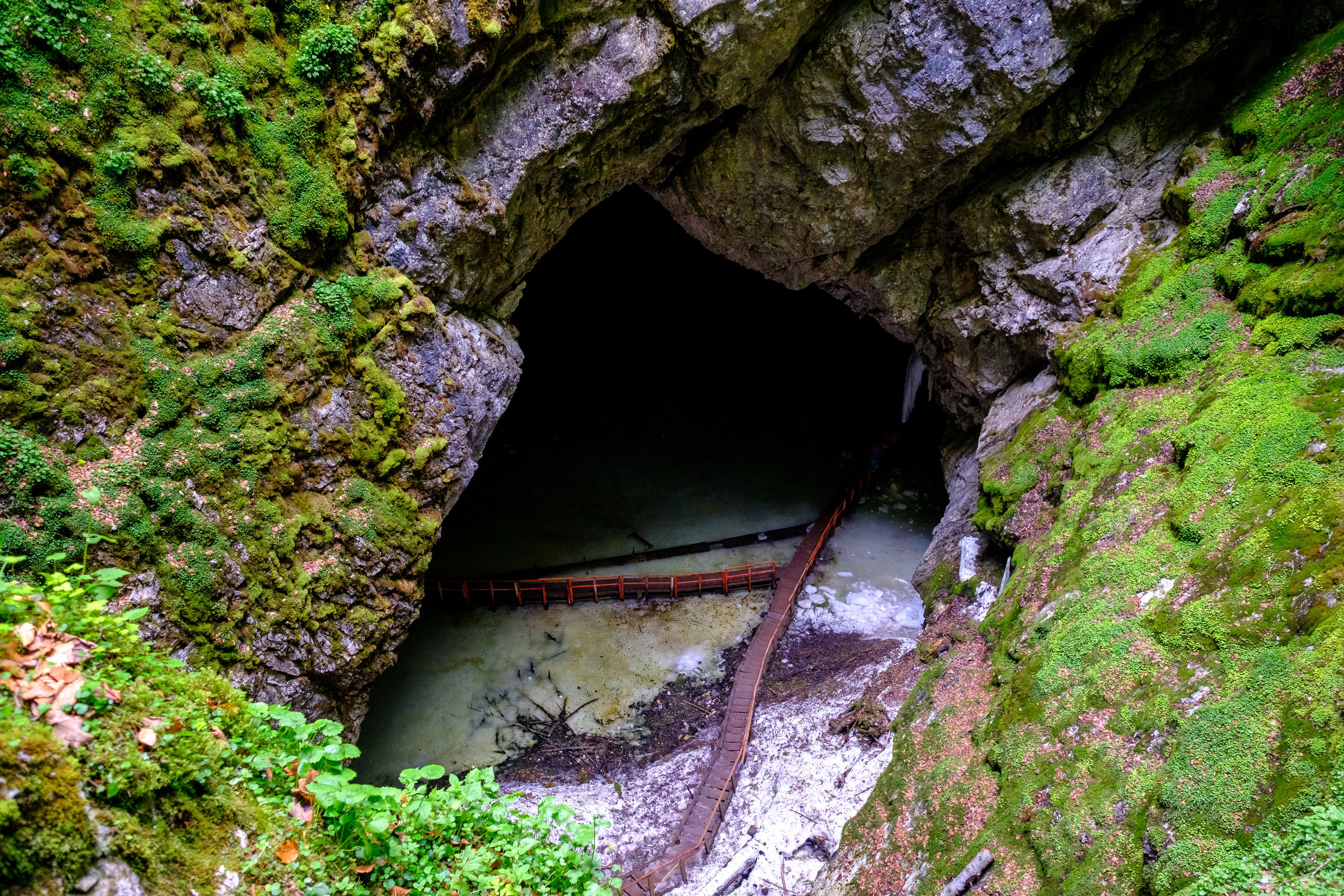 The frozen mouth of Scărișoara cave looms below. Fujifilm X-Pro 2 + 14mm: 1/60 @ ƒ/4 ISO 2500
The frozen mouth of Scărișoara cave looms below. Fujifilm X-Pro 2 + 14mm: 1/60 @ ƒ/4 ISO 2500
The portion of the cave open to the public is relatively small, and even the large hall you walk into once you reach the bottom pales in comparison to some of the massive galleries hiding in the rest of the region’s caves.
Perhaps the most visited cave in the country is Peștera Urșilor (“Cave of the Bears”).
 The final chamber houses a complete skeleton of this cave’s namesake. Fujifilm X-Pro 2 + 14mm: 1/18 @ ƒ/2.8 ISO 6400
The final chamber houses a complete skeleton of this cave’s namesake. Fujifilm X-Pro 2 + 14mm: 1/18 @ ƒ/2.8 ISO 6400
Impressive both in size and natural beauty, Peștera Urșilor got its name from the 140 fossilized cave bear skeletons discovered within. It’s thought that a massive cave-in trapped these prehistoric beasts in the depths more than 27,000 years ago.
Besides the bones, the cave is also home to beautiful rock formations.
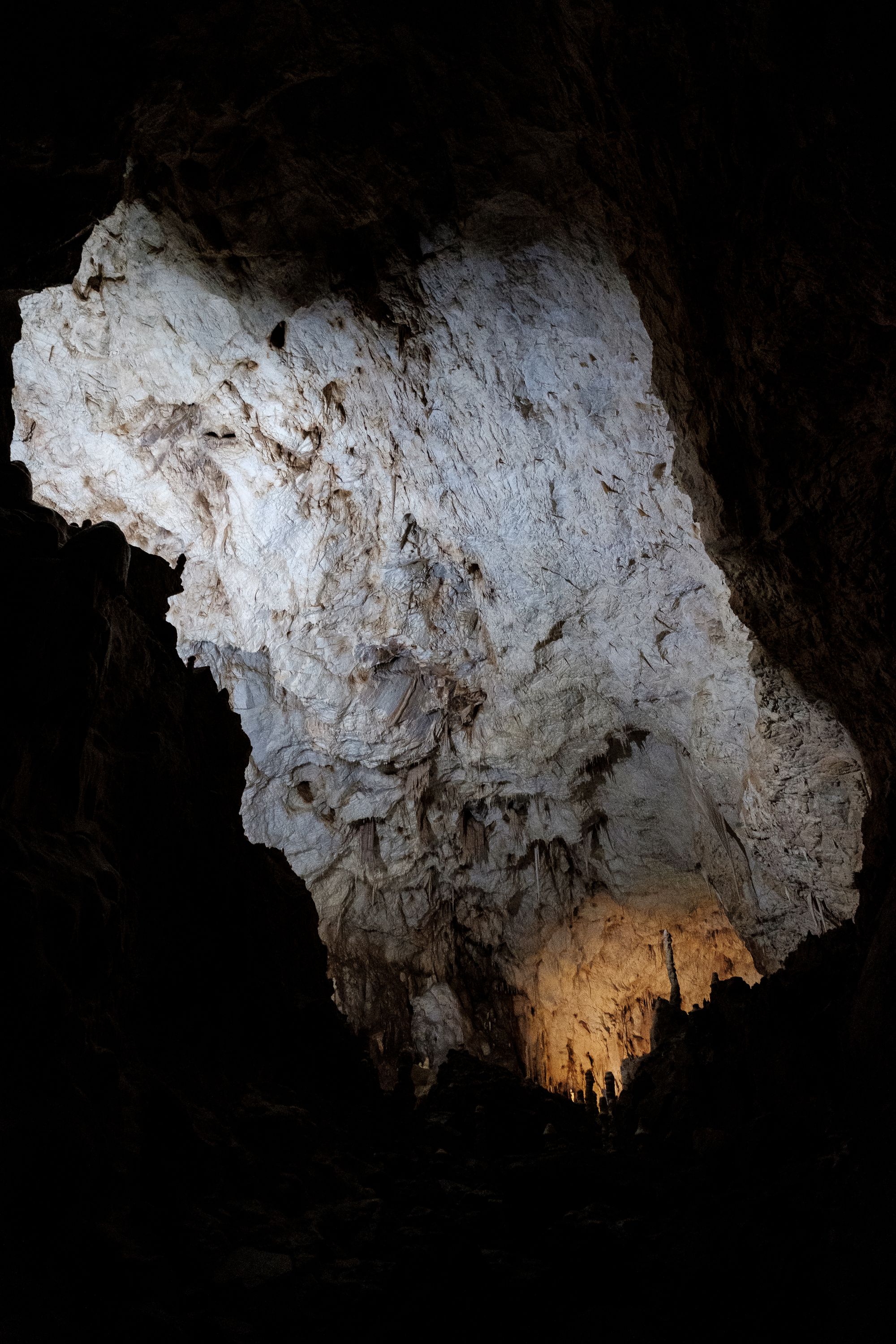 The stalagmite near the orange light is as tall as I am. It takes about ten years for a single centimetre of limestone to accumulate. Fujifilm X-Pro 2 + 14mm: 1/18 @ ƒ/2.8 ISO 6400
The stalagmite near the orange light is as tall as I am. It takes about ten years for a single centimetre of limestone to accumulate. Fujifilm X-Pro 2 + 14mm: 1/18 @ ƒ/2.8 ISO 6400
Transfăgărășan
Those unfamiliar with Romanian history may not recognize the name Nicolae Ceaușescu. It belonged to the country’s second and final communist party leader.
Setting aside unpleasant political history, the man achieved some undeniably impressive things. One world-famous example is the second-tallest road in Romania, the Transfăgărășan.
The formal story behind its construction is that Ceaușescu was trying to build an effective strategic route across the Făgăraș mountains for military troops in response to the Soviet invasion of Czechoslovakia…but such a route already existed.
Instead, it seems likely he did it simply to demonstrate that he could.
The road itself is about 90km long, weaving over and even through the mountains. Remarkably, it was built in just 4 years, from 1970 to 1974. This frantic pace resulted in an estimated 100 deaths during its construction. That doesn’t include the more than 60 who died building the vast Vidraru dam located near the south end of the road.
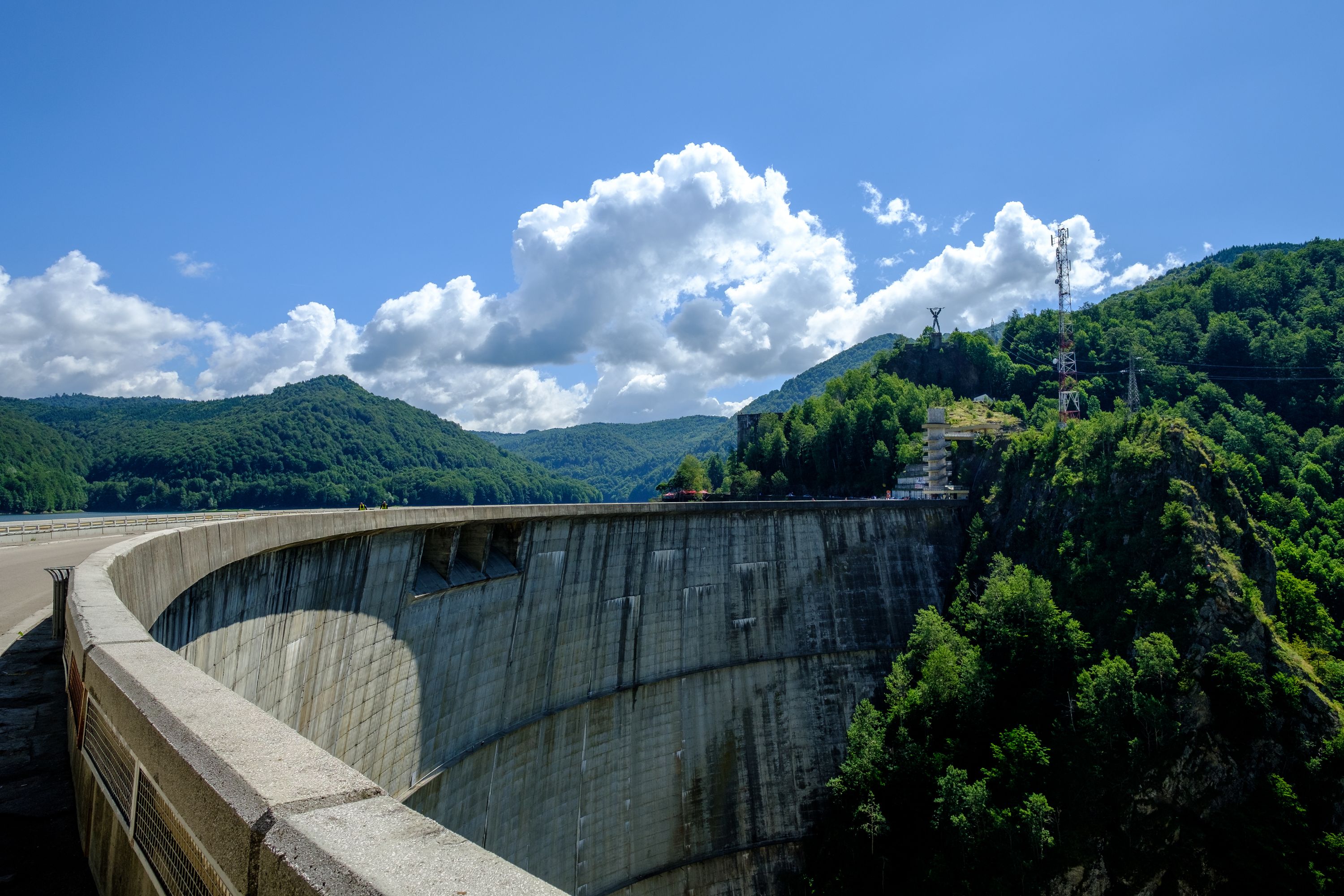 More than 500ft tall, the Vidraru dam is one of the largest in Europe. Fujifilm X-Pro 2 + 14mm: 1/300 @ ƒ/7.1 ISO 400
More than 500ft tall, the Vidraru dam is one of the largest in Europe. Fujifilm X-Pro 2 + 14mm: 1/300 @ ƒ/7.1 ISO 400
Towering over the dam is a steel statue of Prometheus wielding a lightning bolt. Why not, right?
An hour or so north past the dam, we found ourselves in a landscape that seemed to belong in Iceland or Norway, not Romania. The karstic valley of lush grass, jutting rock, and burbling streams make it easy to understand why Top Gear named this the most beautiful road in the world in a 2009 episode.
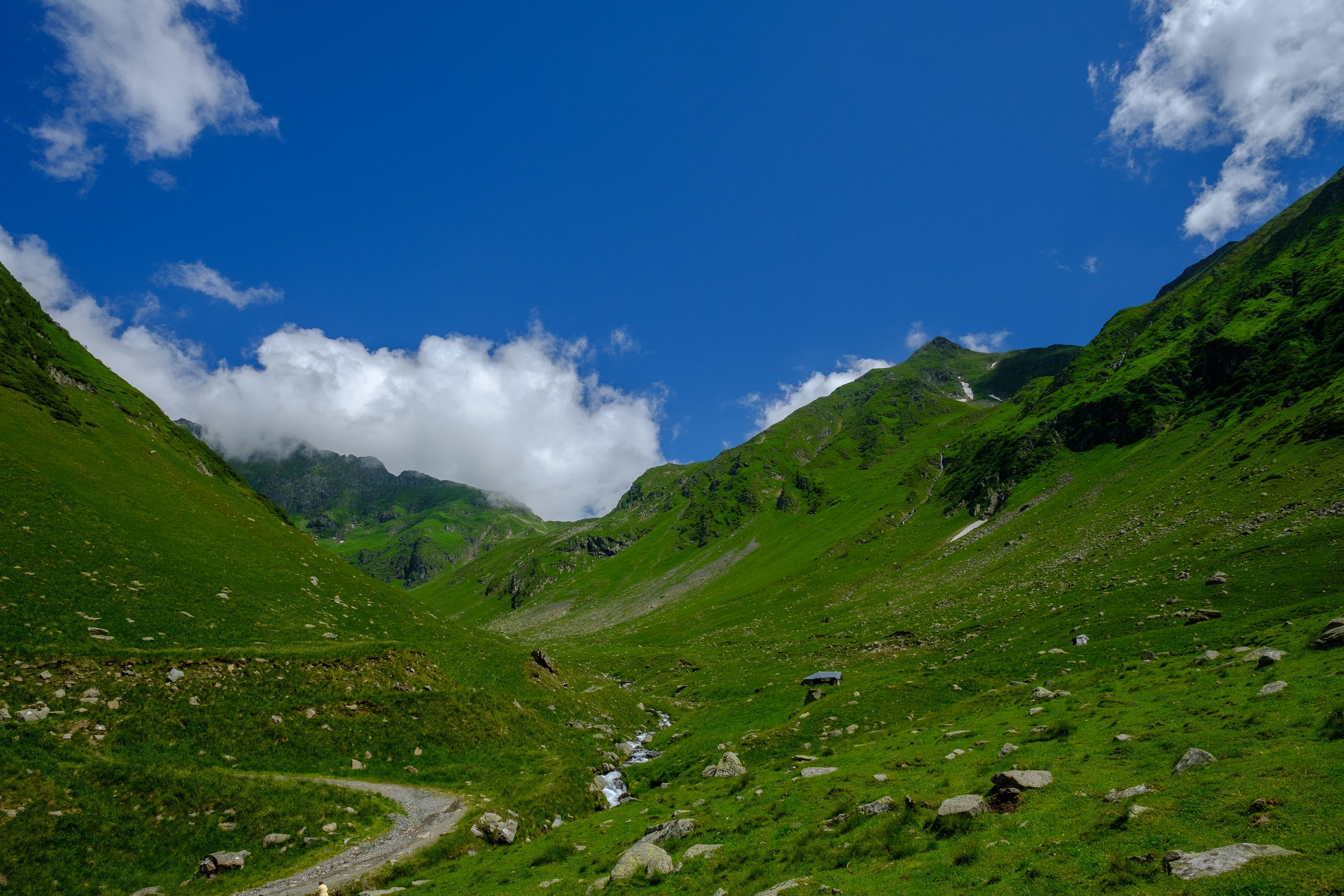 Fujifilm X-Pro 2 + 14mm: 1/400 @ ƒ/7.1 ISO 400
Fujifilm X-Pro 2 + 14mm: 1/400 @ ƒ/7.1 ISO 400
And of course, there are the waterfalls…
 The wonderful 14mm was forgiving as I cranked the aperture to get this effect without ND filters. Fujifilm X-Pro 2 + 14mm: 1/8 @ ƒ/22 ISO 100
The wonderful 14mm was forgiving as I cranked the aperture to get this effect without ND filters. Fujifilm X-Pro 2 + 14mm: 1/8 @ ƒ/22 ISO 100
As the climb continued, we reached a spectacular bowl-shaped mountainside. The road snakes its way up the slope, back and forth, before reaching the longest tunnel, straight through the heart of the mountain.
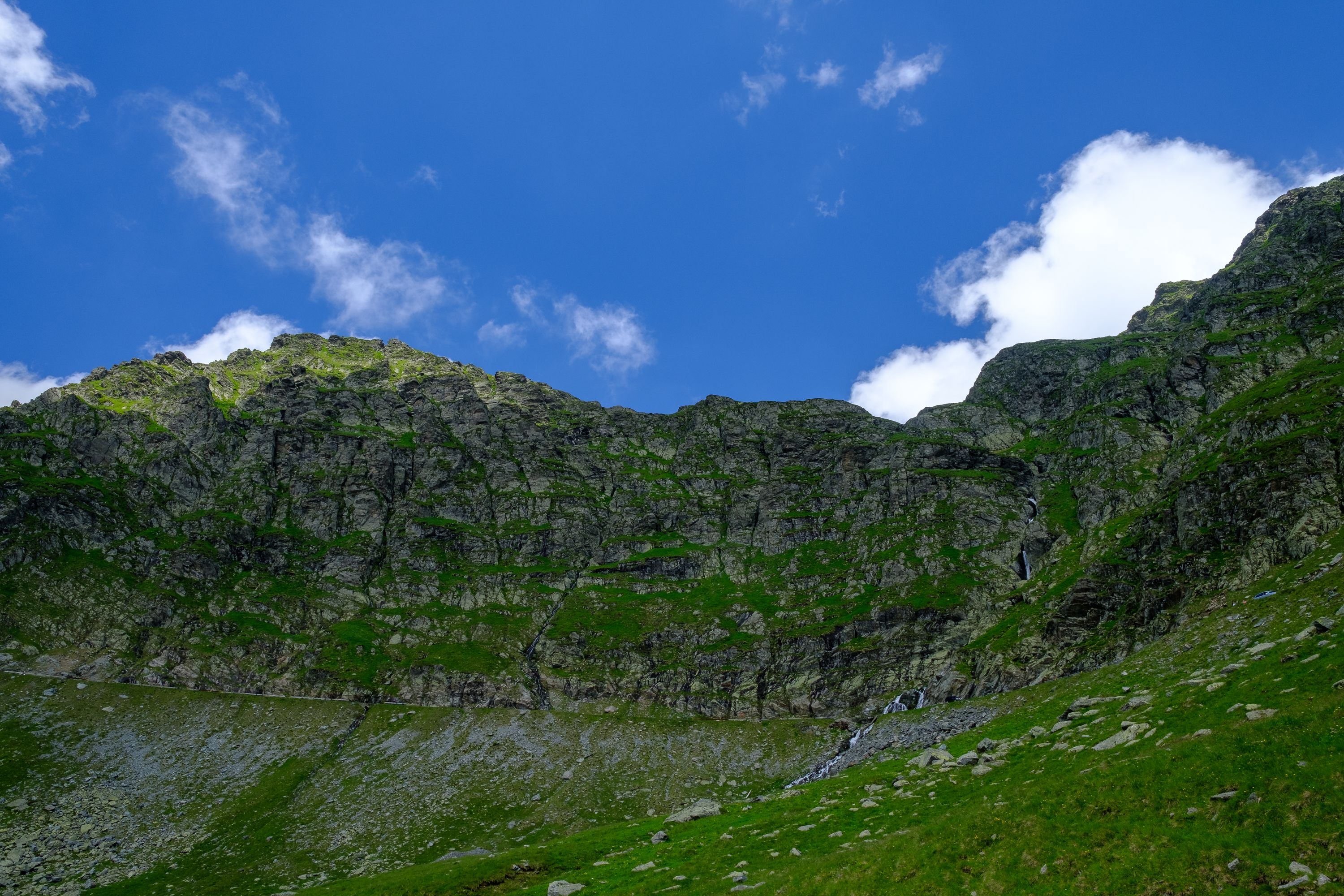 Fujifilm X-Pro 2 + 14mm: 1/110 @ ƒ/8 ISO 400
Fujifilm X-Pro 2 + 14mm: 1/110 @ ƒ/8 ISO 400
Nearly a kilometre in length, this tunnel deposits you at the highest point, more than 2,000m above sea level. Known as Bâlea Lac, this mountain lake was completely invisible when we first emerged from the tunnel.
The mountain shields the bowl from the wind and clouds pushing up against its other side, and we passed through just as a cloud had enveloped the plateau. It was only after a few minutes that the popular stopping point revealed itself.
 iPhone 6s Plus: 1/2404 @ ƒ/2.2, ISO 25
iPhone 6s Plus: 1/2404 @ ƒ/2.2, ISO 25
The weather was in our favour once more, with the clouds casting dramatic shadows on the snow and stone below.
 Fujifilm X-Pro 2 + 14mm: 1/340 @ ƒ/7.1 ISO 400
Fujifilm X-Pro 2 + 14mm: 1/340 @ ƒ/7.1 ISO 400
Nearly every direction was a photographic goldmine. To the left, the red-roofed salvamont station presided over sun-soaked slopes passing in and out of the clouds.
To the right, the lake itself nestled into the stone, its surface still and glassy.
 Fujifilm X-Pro 2 + 14mm: 1/210 @ ƒ/5.6 ISO 200
Fujifilm X-Pro 2 + 14mm: 1/210 @ ƒ/5.6 ISO 200
Walking past these features to the far edge, the crest of a mountain peeks through the clouds, looming over the road’s northern descent.
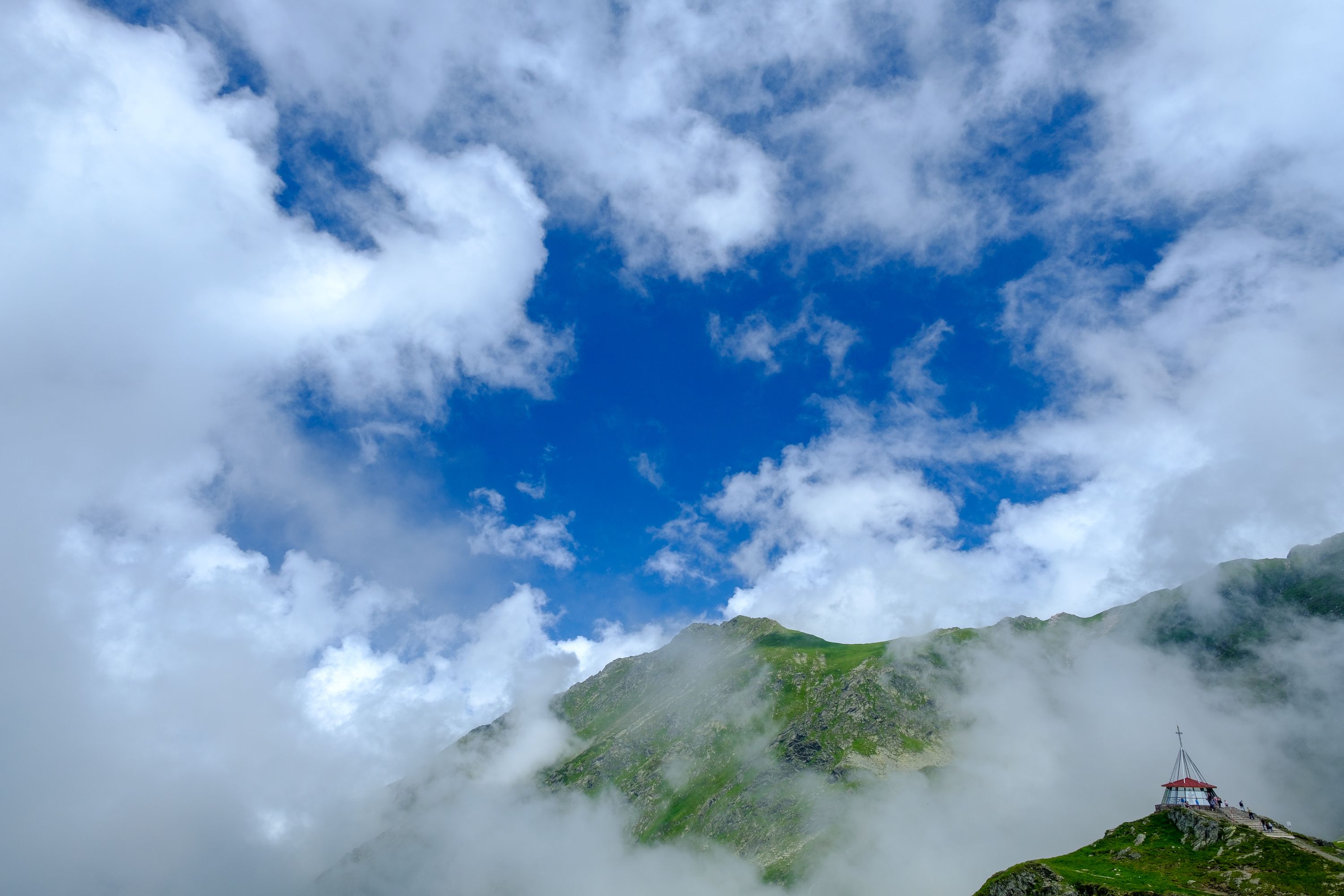 Fujifilm X-Pro 2 + 14mm: 1/340 @ ƒ/7.1 ISO 200
Fujifilm X-Pro 2 + 14mm: 1/340 @ ƒ/7.1 ISO 200
On the way up, the road is hidden mostly in forest, but the descent from Bâlea Lac through the valley reveals the many twists and turns that make this road so scenic.
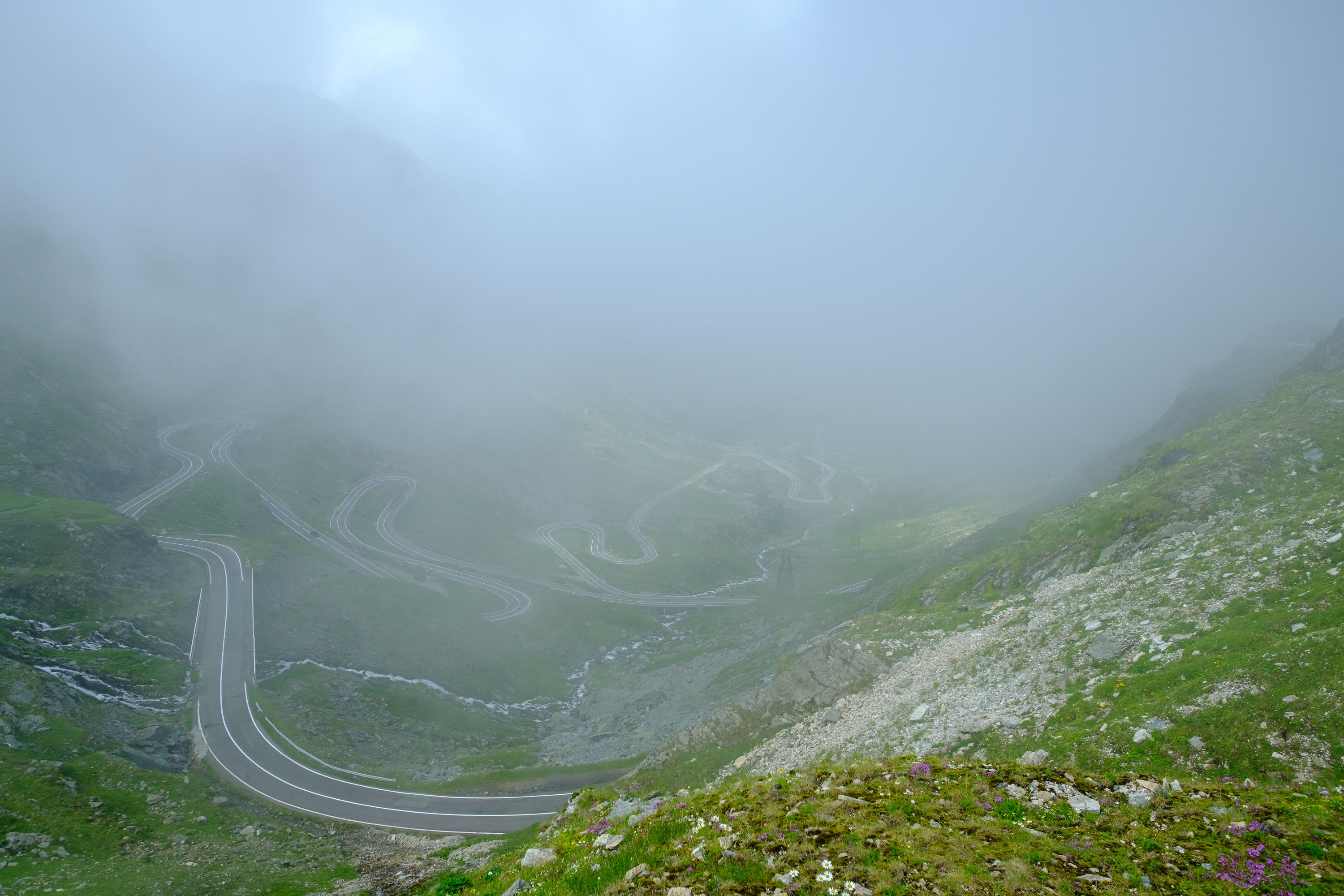 Fujifilm X-Pro 2 + 14mm: 1/250 @ ƒ/5.6 ISO 200
Fujifilm X-Pro 2 + 14mm: 1/250 @ ƒ/5.6 ISO 200
From this vantage point, a team of parachute jumpers took turns leaping off the cliff and using the strong air currents to keep themselves aloft as they cruised through the valley.
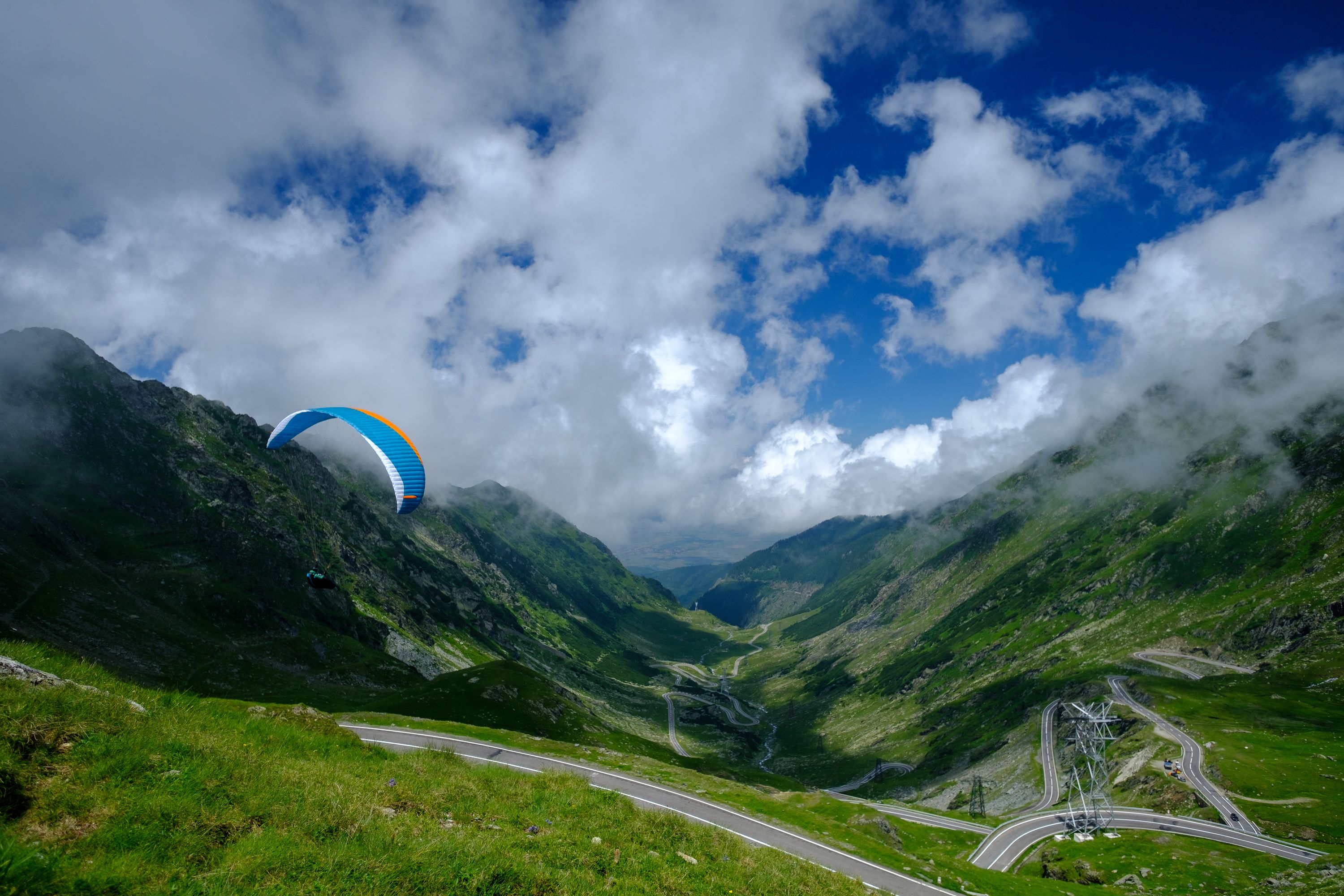 Fujifilm X-Pro 2 + 14mm: 1/1000 @ ƒ/4 ISO 200
Fujifilm X-Pro 2 + 14mm: 1/1000 @ ƒ/4 ISO 200
We took the slower way down.
Along the way, Transfăgărășan had one final surprise for us: a quiet hillside populated by a hundred skeptical sheep and one very sleepy dog.
 The red paint helps shepherds identify their sheep when they graze near another herd.Fujifilm X-Pro 2 + 14mm: 1/2700 @ ƒ/2.8 ISO 400
The red paint helps shepherds identify their sheep when they graze near another herd.Fujifilm X-Pro 2 + 14mm: 1/2700 @ ƒ/2.8 ISO 400
It’s 8:45pm and the cow is staring at a young man pacing in front of his mountain cottage, a camera slung over his shoulder. He stares back, lost in thought. The next morning, he’ll leave this place for another year.
Romania is strange but it is also beautiful. It’s not home, but it’s something like it.
 Fujifilm X-Pro 2 + 23mm: 1/350 @ ƒ/4.5 ISO 400
Fujifilm X-Pro 2 + 23mm: 1/350 @ ƒ/4.5 ISO 400
As we stand there watching the sunset, this cow and I, I realize I’m okay with that.